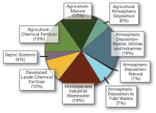|
September 2012 • Volume 11, Number 3
Daniel Strain
Billions of dollars and the fate of the Chesapeake Bay hinge on a set of computer simulations. Who are the scientists behind these "models," and how are their efforts being used to drive the biggest plan to clean up a body of water in U.S. history? Lewis Linker is one of the researchers at the heart of this project. He's the modeling coordinator for the Chesapeake Bay Program, a partnership between state and federal agencies tasked with protecting the nation's largest estuary. With his colleagues in Annapolis, Linker builds computer models to diagnose the Chesapeake's illnesses and investigate new cures. These models seek to represent the Bay's physics, chemistry, and biology using a series of mathematical calculations and some approximations. That's no small task. more . . .
|
|
Maryland Sea Grant Extension specialist Amanda Rockler is working on a project funded by Howard County that trains young people to install rain gardens in public areas locally. Rain gardens are one method for helping to reduce the amount of pollutants and sediment flowing into the Chesapeake. more . . . |
 |
Maryland Sea Grant has a new science writer, Daniel Strain. He will travel the Chesapeake Bay region reporting on the area’s coastal research and its people and economy. more . . . |
Residents of Anne Arundel County were recently invited to a daylong forum to see how future coastal flooding might affect their neighborhoods. more . . . |
|